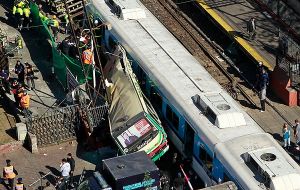MercoPress. South Atlantic News Agency
Bus-trains collision in Buenos Aires leaves 11 dead and hundreds injured
 The derailed train and the smashed bus
The derailed train and the smashed bus A bus driver gambled and tried to rush across railroad tracks on Tuesday despite a barrier, bells and flashing lights, setting off a chain-reaction collision with two trains that killed 11 people and injured hundreds in Argentina's capital.
The shocking accident, captured on video, came as little surprise to many in Buenos Aires, where 440 people and 165 vehicles were hit by trains last year, causing a total of 269 deaths.
In the latest accident, the bus got halfway across the first track before an oncoming passenger train crushed it against a concrete station platform. The collision forced the train's first two cars off the rails and into another locomotive that was leaving the station in the other direction.
The bus driver was among those killed, and 228 were injured, including about 20 people in critical condition, said Alberto Crescenti, director-general of Argentina's emergency medical system. Nine people died at the scene, police said, and two others in hospitals, according to the city's health ministry.
The engineer in the train that hit the bus was trapped in the crumpled metal, and rescuers had to break his leg to get him out. He also broke a hip and his chest was crushed, though he is expected to survive, said union leader Omar Maturano. The Associated Press. The other train's engineer was operated on for a foot injury.
Maturano blamed “how we are as Argentines, that we immediately lift the barriers and cross despite flashing warning signals.”
“It's a cultural problem. There are many people who are accustomed to beating the train,” he said.
Emergency officials were still trying to extricate bodies from under the wreckage hours after the crash.
The collision happened at 6:15 a.m. during the busy morning rush hour in the capital's densely populated Flores neighborhood, when many parents use public transportation to take their children to school. Children were among the injured, according to Argentine Transportation Secretary J.P. Schiavi.
There are hundreds of street-level train crossings in the Argentine capital, and their danger increases at rush hour, particularly next to stations, where trains can arrive every four minutes - so frequently that the crossing barriers remain down most of the time.
While a train is pausing for passengers at a station, there is no way for a driver or pedestrian to know whether the adjacent barrier is blocking street traffic because of that train, or because another train is rushing in from the opposition direction. Buildings line the tracks, making it impossible to see what's coming.
The busy Sarmiento line where Tuesday's accident occurred connects the suburb of Moreno to the capital's center, and has more street-level crossings than any other in Buenos Aires. A $1.2 billion project to move its tracks into an underground tunnel has been delayed for more than a decade due to legal objections from neighbors and financing problems.
Another hazard of Argentina's British-built train system is that trains still move on the left, while roadway driving switched to the right-hand side in 1945, when the Pan-American highway was completed. As a result, some drivers and pedestrians instinctively look the wrong way for approaching trains.
The company that operates the passenger trains issued a statement Tuesday expressing condolences to the victims and stressing that all three automatic warning systems - flashing lights, ringing bells and the physical barrier, were working when the bus tried to cross.
A video taken from the street and broadcast in Argentina, however, showed the red and white-painted arm at a 45-degree angle, narrowly enabling the bus to pass underneath.




Top Comments
Disclaimer & comment rules-

-

-

Read all commentsAm l to believe that Argentina drove on the left until 1945?
Sep 14th, 2011 - 10:38 am 0Terrible tragedy though.
@1 I noticed that fact and it is true. By coincidence I read an article at the weekend about an American asking an English chap why we still drive on the left when Europe drives on the right. The English chap explained that even if there was the will to change it - and the English are notoriously resistent to change - the cost would be prohibitive. The American suggested that they could spread the cost by 'maybe changing one town at a time'. What a sweet thought. : )
Sep 14th, 2011 - 01:08 pm 0The accident is an absolute tragedy and every time I am in Buenos Aires there is some terrible bus crash on the local news channel.
There are no “rules of the road”. Nobody follows the laws whether it is driving or any other. They do whatever they want with impunity, 5 lanes w/7-8 cars across, red light, train no bother go ahead, it is a nightmare! I lived there for a long time and not once did I see a policeman pull over someone for running a light or speeding. The funny thing is they wonder why they have so many vehicular deaths. I think it's the largest % in the Americas.
Sep 14th, 2011 - 01:44 pm 0Commenting for this story is now closed.
If you have a Facebook account, become a fan and comment on our Facebook Page!